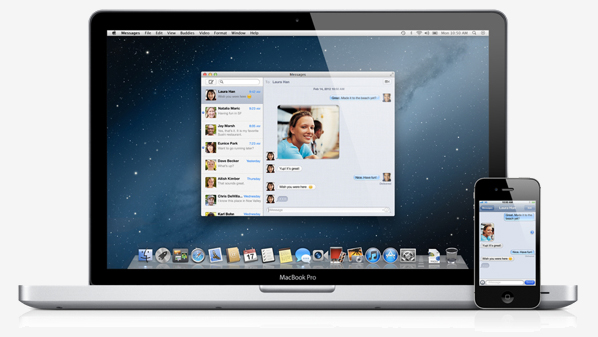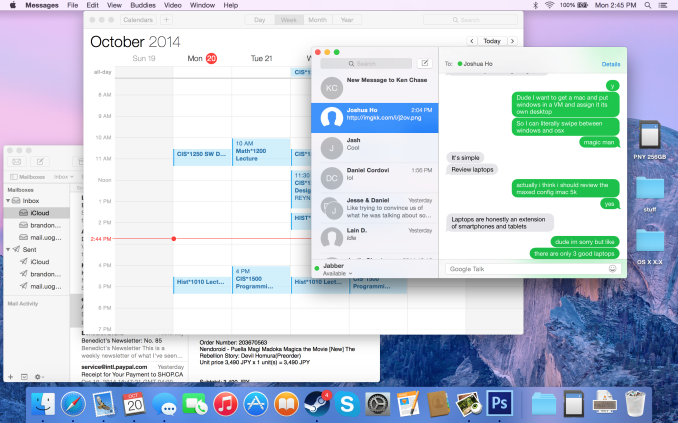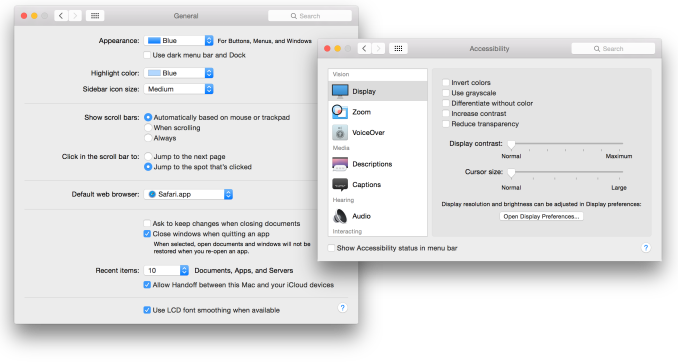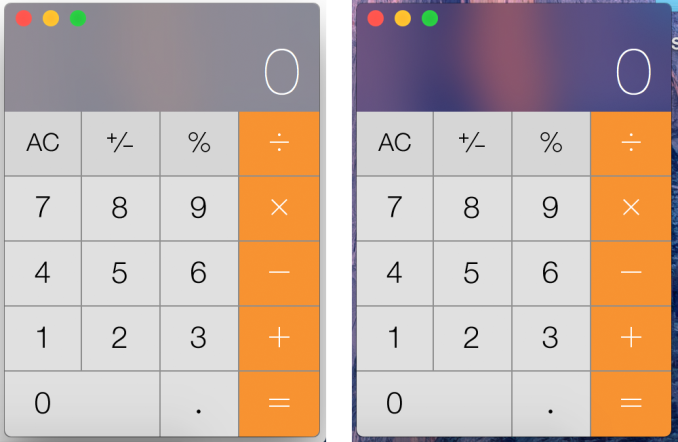A Look At OS X Yosemite And iOS 8.1
by Brandon Chester on October 27, 2014 8:00 AM ESTRethinking OS X
The original interface for iOS was inspired by Apple's Aqua UI, with skeuomorphic elements that mimicked real world objects. Computers have always mimicked the real world to a degree. They have buttons you press, and knobs you turn. The entire desktop metaphor is really just a digitization of the real world office with folders, documents, and a trash can. As computers have evolved and people have become more familiar with them, this overall metaphor has remained for the most part. But many of the visual elements that previously mimicked these real world objects could be simplified to copy in function, but not design. Users who are familiar with computers no longer need a distinct outline and heavy shading to recognize that a button is something they click or tap. They don't want their Calendar and Reminders applications to have leather borders, stitching, and paper like their calendar and date book in the real world, because doing so confines them to the limitations of those physical objects.
iOS 7 was in a sense a rebirth of iOS. The interface that had existed for six years was entirely redone. Core design elements like the homescreen remained, but everything was given a new visual style that eliminated skeuomorphism and ushered in a new era with a new design philosophy for Apple. This style of design is fairly well understood now. iOS makes heavy use of translucency and color. Each application has a primary color throughout which is indicated on its icon. Calendar uses red, Notes uses yellow, etc. With all these massive changes, the future of the design of OS X was uncertain.
One month after we got iOS 7, we got Mavericks. Mavericks was not the major overhaul that iOS 7 was. The visual elements of the operating system were very much the same as previous versions. This can simply be attributed to a lack of engineering resources. Apple's work to redesign iOS most certainly would have began after the departure of Scott Forstall which occurred after the release of iOS 6. Redesigning iOS in less than a year was quite an accomplishment, even with the bugs that were brought along with such a major change. It would have simply been impossible to do the same for OS X within the same period of time.
However, the design in Mavericks did not stand still. While the interface remained the same for the most part, many key applications that implemented skeuomorphic interfaces were redesigned. The leather and stitching was ripped out of apps like Calendar and Notes. The linen was removed from Notification Center and the login screen. These changes were the beginning of the path to what we have now with Yosemite.
For someone used to older versions of OS X, the above interface may seem like a shocking change. But for people who have been exposed to newer versions of iOS, it will actually feel quite familiar. The use of translucency, the flatter interface, and the new system font all draw upon the design principles that were established with iOS 7. It's important to understand what is meant by that. Apple is not establishing a common interface across their devices. OS X and iOS are not the same, and Apple has shown no interest in making them the same. What they are doing is using the same method of design, and the same type of interface elements, to create an experience across those two different operating systems that feels seamless and unified without having to compromise one to fit within the limitations of the other.
I was a fan of Apple's design direction with iOS 7, and so the same has held true for Yosemite. The use of translucency allows the customization of your wallpaper to have an impact on the appearance of the entire operating system. The status bar, the Dock, Launchpad, and any other window that uses translucency can look very different based on the wallpaper that is chosen. Using the new interface tends to have an interesting effect on the user by revealing how dated many parts of the older interface had become. Even users who enjoyed the older design will quickly find themselves questioning how they ever used such a dated interface. It's the same reaction I observed when the iOS userbase moved to iOS 7.
Usability and UI Performance
When the new design of Yosemite was revealed at WWDC 2014, some users voiced concerns that the new design would reduce clarity due to its lighter weighted fonts and heavy use of blur and transparency. On a typical 23" 1080p monitor I haven't noticed any issues reading text that uses the new system font which seems to be a modified Helvetica Neue, but I can see how it may be an issue on non-retina Macbooks where the viewing distance from the display is smaller than a desktop monitor. The blur is also well implemented to preserve legibility. Only the currently active window has the blur effects and transparency enabled. These sections turn opaque when a window is not being used, which means there are not layers upon layers of blur making it difficult to read any text on top of it.
For those who do find that some of the new design choices affect their ability to read or see things, Apple does provide a number of options for accessibility and visual customization. New additions include "Reduce transparency" which removes the translucency effects across the OS, and "Use dark menu bar and Dock" changes the white translucent material in the status bar, the Dock, and Spotlight Search to a black translucent material similar to Notification Center. I tried using the dark mode but I quickly reverted to the original design because the dark menu bar and Dock looked out of place amongst all the white and grey in the rest of the interface.
One issue I have observed with the blur is that windows will show the desktop wallpaper in addition to the applications between which should be blocking the wallpaper from showing through. As you can see above, despite me putting a completely opaque white box behind the calculator, there is still an area with an orange tint in the center. Removing the white reveals that the desktop has the same pattern. During the beta cycle the transparency would only display the wallpaper, and so there was a fix implemented but it introduced a problem of its own. I have seen complaints from other users about this issue, so hopefully it will be remedied in an upcoming update.
Performance is another area of concern with a new design and graphically demanding visual effects like translucency. I have noticed decreases in UI framerate compared to OS X Mavericks based on measurements with Quartz Debug. Overall the OS runs fairly well, but I would be lying if I said it didn't have its issues. Some scrolling lists will regularly drop to somewhere between 30 and 40fps. Scrolling performance in Notification Center is inconsistent, with performance closer to 60fps at some times, and closer to 30fps at others. The worst case I have encountered is the animation for Mission Control which has dropped as low as 5fps when many applications are open. Going forward it will be interesting to see how quickly and to what degree these issues are fixed by Apple.














173 Comments
View All Comments
Brett Howse - Monday, October 27, 2014 - link
You can actually tether to a Windows Phone from the laptop without touching the phone - just like the Apple method it connects to the phone over Bluetooth and then turns on the hotspot. So yes to that one.But no to everything else they need to do more work on integrating the experiences of phone and desktop.
andrewaggb - Monday, October 27, 2014 - link
well microsoft tablets run windows, so they basically have the same capabilities. They do have smartglass for the xbox which allows browser transitions between tablet and xbox (works with an ipad as well). I don't have a windows phone.I know the playto feature to play movies and stuff to the xbox one and 360 (and other dlna players) works great.
SkyDrive sync's your windows profile/files etc across tablet and pc.
It's not perfect by any stretch, but there's definitely integration. I use the same billing account for my microsoft azure cloud services as I do for my xbox, it's all tied to my microsoft account. As was a purchase from the microsoft online store.
The sms and call transferring stuff is cool though, hopefully they grab that as well. Windows media center integration with the xbox 360 was great, but unfortunately that product is gone.
Bob Todd - Monday, October 27, 2014 - link
Ah cool! One feature down. I really hope they put an emphasis on tying all of their big offerings together (desktop/phone/tablet/Xbox/etc.) in meaningful ways like that.DarkXale - Monday, October 27, 2014 - link
1) Yes.2) Theres a standard bluetooth profile for that; started doing it in the feature phone era. This is old even on Apple's side.
3) Yes again. See point number two. Feature phones sometimes required their 'Suite' software for this to work fully.
Impulses - Friday, October 31, 2014 - link
Does the Bluetooth profile actually pair the phone via Wi-Fi tho? Tethering over Bluetooth itself would be kind of a bottleneck if you have a particularly good LTE connection... I remember tethering over just BT back on the day with my netbook and Sony Ericsson phone, didn't have to turn anything on in the phone either, but this was back before 3G!HisDivineOrder - Monday, October 27, 2014 - link
I think Apple's incentivizing of staying in their ecosystem is interesting for the user who will do that or has the money to do it. That said, I think Google started the ball rolling and Microsoft has joined now too with a lot more emphasis than even Google at making broad compatibility across lots of platforms, which I think is probably the better way forward.Apple is a devices company. It's obvious. Google is a marketing company and so they emphasize their services as a way to get more info to use for marketing. Microsoft wants to be both Apple and Google, but Nadella seems keen to focus Microsoft on the Services part of that equation, which is wise because their devices just won't sell very well save for some high end Surface tablets to some ultra niche customers.
I think Microsoft's approach of making their services envelop other platforms so if you have an Android phone and a Windows PC and an iPad, you can use all your platforms to see OneDrive or Office 365 is the most convenient one for the typical consumer with the typical budget.
I think Apple's way is the most convenient one for Apple and the few people who have the budget to afford all Apple devices and the Apple Tax that goes with them.
odedia - Monday, October 27, 2014 - link
Guys, when is the iMac retina 5k due to appear? It's the one thing keeping me from ordering it.Ryan Smith - Monday, October 27, 2014 - link
Next week.Anandrian - Monday, October 27, 2014 - link
I think the article is spot on."You can only use the whole apple ecosystem if you have apple hardware/software"
Take full advantage of the ecosystem, yes! but that's the apple way. They control every aspect of the ecosystem to guarantee a better than average experience and I think they've succeed.
"OS X Yosemite not innovative"
That may be so, but it is damn good even if it's not innovative. At this point in time the improvements or new features might not be ground breaking but when you used them regularly you can really understand the advantage of them. This also is true for windows 8.1, some people hate it and some people love it and in my own experience, I like what win 8.1 brings to the table the way I use it.
"Apple is expensive"
Yes it is, is it worth it? I guess that's personal. I do have a 2009 13" macbook pro and it's still working fine with OS X Yosemite (I did upgrade my HDD to an SDD an the memory from 4GB to 8GB almost since I bought it). And I also have an awesome watercooled pc with win 8.1 which I built myself, I use it for programming and gaming and it is awesome!. I really like both machines however I do have an iphone and an ipad and I like what the apple ecosystem brings to the table, would I like it to have more features? yes, of course but that will come with future iOS and OS X releases just as it will happen with Microsoft and Google and all the other players out there.
Don't hate guys! just enjoy :D
mfenn - Monday, October 27, 2014 - link
"I had never used it until Yosemite rolled out with the new capabilities that Apple had built in."What??? How did you launch applications before?